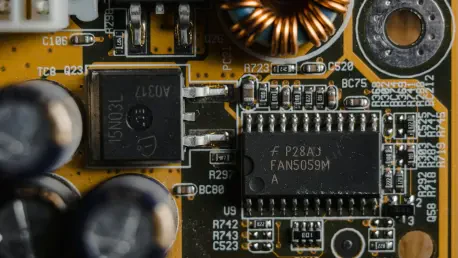In an era where technology permeates every facet of daily life, semiconductors have emerged as the silent yet indispensable force propelling the most groundbreaking innovations forward. These tiny silicon marvels underpin the functionality of everything from sophisticated artificial intelligence systems to the sprawling networks of the Internet of Things (IoT), the lightning-fast capabilities of 5G, and the complex operations of autonomous vehicles. Often overshadowed by the buzz surrounding AI, the true catalyst of progress lies in the relentless advancement of semiconductor technology, which equips devices with intelligence, enables seamless connectivity, and empowers vehicles to navigate without human intervention. This exploration delves into the pivotal role these chips play in crafting a future where intelligence is ubiquitous, bridging the digital and physical realms in ways previously unimaginable.
The synergy among IoT, 5G, and autonomous vehicles highlights a dynamic interplay, with semiconductors serving as the central pillar, driving innovation across these fields. Progress in one domain often accelerates developments in the others, creating a continuous cycle of innovation. For example, the ultra-fast networks of 5G, powered by cutting-edge chips, facilitate real-time data exchange for IoT ecosystems, while the immense computational needs of self-driving cars push semiconductor design to new frontiers. Beyond their technical contributions, these components are reshaping societal structures and economic landscapes, driving industrial growth, enhancing safety through automation, and revolutionizing healthcare with connected solutions. Yet, alongside these advancements come pressing challenges, including cybersecurity vulnerabilities and ethical considerations, which demand careful navigation as technology continues to evolve.
The Foundation of Emerging Technologies
Semiconductors as the Core Enabler
Semiconductors form the essential foundation for the transformative technologies defining the modern age, including IoT, 5G, and autonomous vehicles. These chips deliver the critical processing power, connectivity, and energy efficiency required to breathe life into smart sensors, high-speed communication networks, and self-driving systems. Their presence is felt in every connected device, from household gadgets monitoring energy use to industrial equipment optimizing production lines. Without the steady evolution of semiconductor capabilities, the vision of a hyper-connected world would remain a distant dream, as these components enable the seamless integration of intelligence into everyday objects. Their role extends beyond mere functionality, acting as the heartbeat of innovation across diverse sectors, ensuring that devices not only perform tasks but do so with precision and reliability.
Moreover, the adaptability of semiconductors to various applications underscores their significance in driving technological progress. In the context of 5G, they manage the intricate demands of high-frequency signals and vast device connectivity, making ultra-low latency a tangible reality. For autonomous vehicles, often dubbed “servers on wheels,” semiconductors process massive streams of data from sensors like cameras and LiDAR, facilitating split-second decisions critical for safety. This versatility positions them as indispensable assets, bridging the gap between theoretical possibilities and practical implementations. As industries continue to push boundaries, the reliance on these chips to handle increasingly complex tasks only deepens, cementing their status as the linchpin of a connected era.
Symbiotic Growth Across Fields
The relationship between IoT, 5G, and autonomous vehicles is inherently interdependent, with semiconductors acting as the catalyst for mutual advancement, and each technological domain fuels innovation in the others, creating a powerful feedback loop that accelerates progress. For instance, the enhanced data speeds and low latency of 5G networks, enabled by advanced semiconductor designs, allow IoT devices to transmit information in real time, enhancing their utility in smart homes and cities. Simultaneously, the data-intensive nature of autonomous vehicles, which rely on real-time processing for navigation and safety, drives the development of more powerful and efficient chips. This interconnected growth illustrates how advancements in one area ripple across the technological landscape, amplifying overall impact.
This symbiotic dynamic also reveals the escalating demands placed on semiconductor technology as these fields evolve, highlighting the intricate balance between innovation and necessity. As IoT ecosystems expand to encompass billions of devices, chips must become smaller and more energy-efficient to fit within constrained designs while maintaining performance. In parallel, the rollout of 5G infrastructure necessitates semiconductors capable of handling higher frequencies and larger data volumes without compromising reliability. Autonomous vehicles add another layer of complexity, requiring chips that can integrate AI for decision-making while adhering to stringent safety standards. This continuous push and pull between technology needs and semiconductor innovation fosters an environment of rapid development, where each breakthrough paves the way for the next, shaping a future of unprecedented connectivity.
Technical Innovations in Chip Design
Specialization and Miniaturization
The semiconductor industry is witnessing a profound shift toward specialization, where chips are increasingly engineered for specific purposes to meet the unique demands of modern technologies. Unlike the general-purpose processors of the past, today’s designs target precise applications, such as AI-driven processing for autonomous vehicles or ultra-low-power solutions for IoT devices. This trend is complemented by relentless efforts in miniaturization, with manufacturing processes shrinking to 3nm and even 2nm scales. Such advancements allow for the creation of smaller, more efficient devices that can be embedded into compact form factors without sacrificing capability. This dual focus on tailored functionality and reduced size is critical for enabling the proliferation of smart technology across diverse environments, from wearable health monitors to industrial sensors.
Additionally, the drive for specialization and miniaturization addresses the pressing need for energy efficiency, a key concern in an era of pervasive connectivity. IoT devices, often battery-powered and deployed in remote locations, rely on semiconductors that consume minimal power to extend operational life over years. Similarly, the compact nature of modern chips ensures they can fit within the tight spatial constraints of consumer electronics and automotive systems, while still delivering robust performance. This balance of efficiency and power is not merely a technical achievement but a necessity for scaling technologies like IoT and 5G to global levels. As the industry continues to refine these aspects, the potential for integrating intelligence into even the smallest devices grows, promising a future where connectivity is truly ubiquitous.
Advanced Materials for Performance
A significant leap in semiconductor technology comes from the adoption of wide-bandgap (WBG) materials such as gallium nitride (GaN) and silicon carbide (SiC), which are steadily replacing traditional silicon in high-performance applications. These materials excel in handling high-frequency signals and elevated power levels, making them ideal for the demands of 5G networks and electric vehicles (EVs). Unlike conventional silicon, WBG materials offer superior efficiency and better thermal management, reducing energy loss and enhancing device reliability under extreme conditions. This shift is pivotal for supporting the infrastructure of next-generation connectivity and sustainable transportation, where performance cannot be compromised.
Furthermore, the integration of these advanced materials addresses the growing complexity of technological requirements in modern systems. In 5G, for instance, GaN enables chips to process millimeter-wave signals essential for ultra-fast data speeds, while SiC supports high-power applications in EV powertrains, improving range and charging efficiency. This transition not only boosts operational capabilities but also aligns with broader goals of sustainability by minimizing energy waste. As industries increasingly prioritize eco-friendly solutions, the role of wide bandgap (WBG) materials becomes even more critical, offering a pathway to meet stringent performance standards without environmental trade-offs. Their continued development and adoption signal a transformative era for semiconductor design, tailored to the unique challenges of today’s technological landscape.
Edge Computing and AI Integration
The integration of artificial intelligence into edge devices represents a paradigm shift in how data is processed, moving away from centralized cloud systems to localized, real-time computation. This approach significantly reduces latency, a crucial factor for technologies like autonomous vehicles, where split-second decisions can mean the difference between safety and catastrophe. By embedding AI capabilities directly into semiconductors, devices can analyze and act on data at the source, whether it’s a car processing sensor inputs or an IoT sensor monitoring environmental changes. This trend not only enhances responsiveness but also alleviates bandwidth strain on networks, supporting the scalability of connected ecosystems.
Beyond performance, edge computing with AI integration offers substantial benefits for data privacy and security, addressing growing concerns in a hyper-connected world. Processing sensitive information locally minimizes the need to transmit data to external servers, reducing exposure to potential breaches—a vital consideration for IoT devices in healthcare and smart homes. Additionally, this method optimizes power consumption, as devices avoid the energy-intensive task of constant cloud communication. For autonomous systems, edge AI ensures compliance with stringent safety protocols by enabling instantaneous responses to dynamic conditions. As this technology matures, its impact on fostering trust and reliability in connected systems will likely deepen, paving the way for broader adoption across industries.
Corporate Strategies and Market Dynamics
Competition and Vertical Integration
The semiconductor sector is a battleground of innovation and strategy, with industry giants like NVIDIA, Qualcomm, and TSMC holding dominant positions through cutting-edge advancements and manufacturing prowess. NVIDIA leads in AI-driven GPUs essential for autonomous vehicles, while TSMC remains the world’s preeminent foundry, producing the majority of advanced chips for global markets. Meanwhile, a notable shift is occurring as tech behemoths such as Apple and Google venture into custom chip design, pursuing vertical integration to control both hardware and software ecosystems. This trend disrupts traditional supplier dynamics, intensifying competition and pushing established players to innovate or risk losing market share in a rapidly evolving landscape.
This strategic pivot toward vertical integration reflects a broader industry realization that tailored solutions often outperform off-the-shelf components in efficiency and performance, highlighting a significant shift in business approach. By designing proprietary semiconductors, companies can optimize their products for specific applications, whether it’s enhancing smartphone capabilities or powering cloud AI services. However, this move poses challenges for conventional manufacturers, who must adapt by diversifying offerings or forging deeper partnerships with foundries. The competitive pressure also fuels innovation, as firms race to develop the next breakthrough in chip technology. Amid this rivalry, the stakes are high, with market leadership hinging on the ability to anticipate and meet the nuanced demands of emerging technologies like IoT and 5G.
Market Growth and Supply Chain Risks
Projections indicate that the global semiconductor market will soar beyond $1 trillion by 2030, driven by insatiable demand from IoT, 5G, and autonomous vehicle sectors. The automotive industry alone is expected to contribute significantly, with estimates pegging its semiconductor segment at $129 billion by the same timeframe. This explosive growth underscores the economic importance of these chips, as they enable advancements across smart cities, industrial automation, and consumer electronics. However, such rapid expansion also amplifies vulnerabilities, particularly in supply chains strained by geopolitical tensions and production bottlenecks, which have already led to global shortages in recent times.
Mitigating these supply chain risks remains a critical challenge for sustaining market momentum, especially since disruptions, whether from natural disasters or international trade disputes, can halt production and delay technological rollouts. These interruptions impact everything from smartphone availability to automotive manufacturing, creating widespread consequences. Industry leaders and policymakers are increasingly advocating for diversification, such as expanding manufacturing bases across multiple regions to reduce dependency on single sources. Investments in domestic production capabilities are also gaining traction as a means to bolster resilience. Addressing these vulnerabilities is not merely a logistical concern but a strategic imperative, as the stability of the semiconductor supply chain directly influences the pace of innovation and economic growth in a tech-driven world.
Societal and Economic Impacts
Transforming Industries and Daily Life
Semiconductors are at the forefront of reshaping industries and enhancing daily experiences through their role in enabling smart cities, autonomous mobility, and connected healthcare. In urban environments, IoT devices powered by these chips facilitate real-time data analytics for traffic management, energy optimization, and public safety, creating more efficient and livable spaces. Autonomous vehicles promise to revolutionize transportation by reducing accidents caused by human error, while also transforming logistics with self-driving fleets. In healthcare, connected devices enable remote patient monitoring and AI-driven diagnostics, improving access to care and patient outcomes across diverse populations.
Economically, the influence of semiconductors is profound, acting as a catalyst for growth across multiple sectors. The automotive industry’s shift to electric and autonomous vehicles is fueling a semiconductor boom, while initiatives like Industry 4.0 leverage these chips for smart manufacturing and predictive maintenance, driving operational efficiencies. Smart city projects, supported by 5G connectivity, are expected to generate significant economic value by optimizing resource use and enhancing infrastructure. This widespread adoption not only boosts productivity but also creates new markets and job opportunities in technology development and deployment, positioning semiconductors as a cornerstone of modern economic progress.
Challenges and Ethical Concerns
Despite their transformative potential, semiconductors introduce complex societal challenges that must be navigated with caution, especially as the proliferation of connected devices heightens cybersecurity risks. Each endpoint in an IoT network represents a potential vulnerability for data breaches or malicious attacks. This concern is particularly acute in critical sectors like healthcare and infrastructure, where breaches could have severe consequences. Additionally, the automation enabled by these chips, especially in transportation and manufacturing, raises the specter of job displacement, as machines increasingly perform tasks once done by humans, necessitating strategies for workforce retraining and adaptation.
Ethical dilemmas further complicate the landscape, particularly with AI-driven autonomous systems reliant on semiconductor technology, where complex challenges arise. In self-driving vehicles, for instance, algorithms must make split-second decisions in life-or-death scenarios, raising critical questions about accountability and moral programming. Who bears responsibility if an autonomous car causes harm, and how should such systems prioritize outcomes? These unresolved issues highlight the need for robust frameworks to address the societal implications of rapid technological advancement. Balancing innovation with ethical considerations will be crucial to ensure that the benefits of semiconductors are realized without exacerbating social inequities or compromising safety.
Future Horizons and Challenges
Near-Term Innovations
Looking ahead to the next few years, the semiconductor industry is poised for significant advancements that will further enhance the capabilities of IoT, 5G, and autonomous technologies. Edge AI is set to become more prevalent, enabling devices to process complex data locally with minimal latency, a development critical for real-time applications like self-driving cars and smart surveillance. Additionally, advanced packaging techniques such as 3D stacking and chiplets are gaining traction, allowing for greater integration of components within smaller footprints. These innovations promise to boost performance and efficiency, ensuring that devices can handle increasingly demanding tasks without compromising on size or power consumption.
Another area of focus in the near term is the refinement of energy-efficient designs to support the massive scale of connected ecosystems. As billions of IoT devices come online, semiconductors must minimize power usage to sustain long-term operation, particularly in remote or battery-dependent settings. Progress in low-power microcontrollers and System-on-Chips (SoCs) will play a pivotal role in this effort, enabling sustainable deployment across industries. Furthermore, improvements in 5G chipsets will enhance network reliability and device connectivity, laying the groundwork for broader adoption of smart technologies. These near-term developments are not just incremental but foundational, setting the stage for more ambitious breakthroughs in the years to come.
Long-Term Breakthroughs
Over a longer horizon, the potential for semiconductor technology to redefine the technological landscape becomes even more striking, with innovations like neuromorphic computing and energy harvesting on the cusp of realization. Neuromorphic chips, designed to mimic the human brain’s neural structure, could revolutionize processing efficiency, offering unprecedented capabilities for AI applications in autonomous systems and beyond. Energy harvesting, meanwhile, holds promise for IoT by enabling devices to power themselves through ambient sources like solar or thermal energy, eliminating the need for frequent battery replacements and enhancing sustainability in remote deployments.
Additionally, the emergence of 6G networks and quantum computing represents a transformative frontier for semiconductor applications, promising to reshape technology as we know it. While still in the early stages, 6G is expected to deliver ultra-reliable communication with near-zero latency, necessitating entirely new chip architectures to handle its demands. Quantum computing, with its potential to solve complex problems beyond the reach of classical systems, could redefine data security and processing power, particularly for industries reliant on vast datasets. These long-term prospects, though speculative, underscore the limitless possibilities of semiconductor innovation, provided research and development efforts continue to push boundaries and address the inherent complexities of such groundbreaking technologies.
Overcoming Industry Hurdles
The path to realizing the full potential of semiconductors is fraught with significant challenges, including high manufacturing costs that strain resources and limit scalability. Producing advanced chips at scales like 2nm or 3nm requires cutting-edge facilities and substantial investment, often out of reach for smaller players in the market. These costs are compounded by the complexity of integrating new materials and designs, which demand specialized expertise and equipment. Tackling this issue will require innovative approaches to manufacturing, such as shared infrastructure models or government-backed incentives, to democratize access to advanced production capabilities.
Supply chain fragility presents another formidable obstacle, as the industry remains vulnerable to disruptions from geopolitical tensions, natural disasters, and raw material shortages, highlighting the urgent need for strategic improvements. Recent global chip shortages have exposed the risks of over-reliance on concentrated manufacturing hubs, prompting calls for diversification and localized production. Simultaneously, a persistent shortage of skilled talent in semiconductor design and engineering threatens to slow innovation, as the demand for expertise outpaces supply. Addressing these hurdles requires a collaborative effort between industry stakeholders and policymakers to invest in education, bolster supply chain resilience, and foster international cooperation. Only through such unified strategies can the momentum of technological advancement be sustained, ensuring that semiconductors continue to drive progress without interruption.









